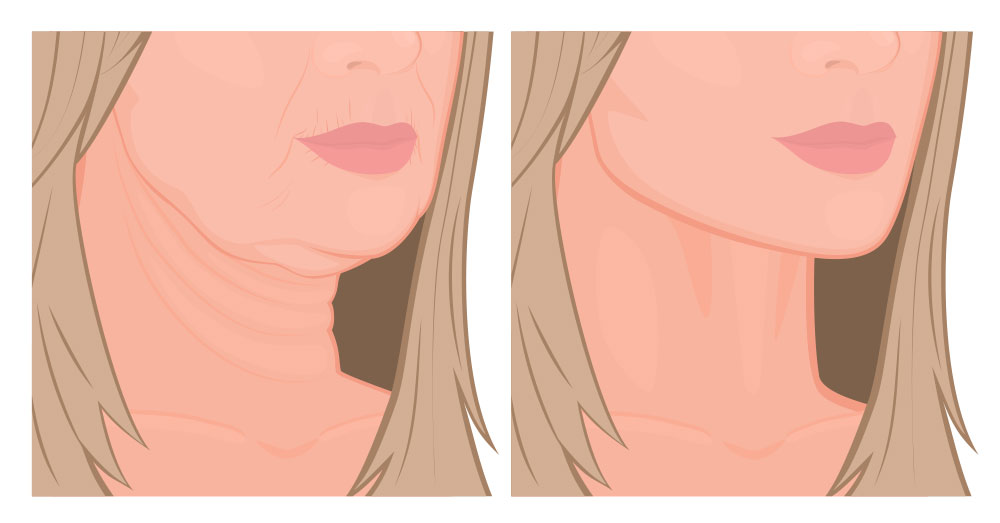


The first facelifts were performed in Berlin in the early 1900’s and consisted of removal of a small strip of skin near the ear, tightening the cheek skin slightly. Since then the “facelift” has undergone many significant modifications and when performed properly will yield reproducibly and reliably natural results in a safe manner.
The word “facelift” (or “rhytidectomy”) is actually a misnomer because the operation more correctly repositions rather than lifts the tissues, and is most often directed at the contours of the jawline and the neck, and not exclusively the face. A “mini-facelift” restricts its goals to improvement of the contour above the jawline. A “necklift” refers to those procedures aimed at improvement of the contour below the jawline in the neck only. A “short scar facelift” is able to improve the contour above, and to a lesser degree in the neck than a “full facelift”, but does so with a shorter scar behind the ear. The overall approach in men and women is slightly different. Dr. Sultan will evaluate your needs and choose the correct procedure with you.
The face has three layers of tissue. The most superficial is the skin itself and the deepest are the muscles of facial expression which allow us to smile and animate. Between those two layers is a sheet of tissue called the SMAS (superficial musculoaponeurotic system). The tissue begins at the cheek bone, extends inferiorly through the cheek, down across the jawline, onto the neck, where it fuses with another muscle of facial expression called the platysma. Those operations which rely on repositioning and tightening the SMAS rather than the skin itself are called “Deep Plane Facelifts”. Beginning with his Fellowship training in Oncologic and Reconstructive Surgery of the Head and Neck, Dr. Sultan has accumulated a great deal of experience in surgery of the deeper layers of the face, has applied that to cosmetic procedures, and so has become a noted expert in cosmetic Deep Plane facial surgery.
The surgery is done under general anesthesia because this method provides the most secure management of the patient’s airway. We understand that some are concerned by the concept of general anesthesia and we will be happy to review this further at the consultation. The surgery begins with inconspicuous incisions around and within the ear. A small amount of skin is elevated, exposing the SMAS below. The technique relies on elevation and upward anchoring of the deep tissues, the SMAS, to reposition and smooth the jawline skin as well as the neck skin and muscle. There is some skin excised near the ear but the skin can be closed passively without tension, guaranteeing a non-pulled appearance. The objective is a youthful face, a crisp jawline, a snug neck and above all, a natural appearance. Those goals are routinely and safely achieved by these methods in Dr. Sultan’s hands.
A relatively new advance in facial rejuvenation is the almost routine use of supplemental fat injections to further improve the results of facelift surgery. When we age, our skin thins and therefore adding back a microscopic amount of fat into strategic sites to thicken the skin will improve the overall result. Those patients with a weak chin may be offered fat injections to this area or even a chin implant to further improve the contour of the jawline and improve their profile. As mentioned earlier, facelift surgery aims to address facial and neck contour, but not to eliminate all wrinkles. However, wrinkles can be improved on the same day of the lift by one of several modalities, namely chemical peels, micro-dermabrasion, or radiofrequency.
Preparation for a facelift includes medical clearance when appropriate, strict avoidance of medications for two to three weeks like aspirin or Advil that can cause bleeding, and abstinence from all smoking for three to six weeks. Several days before surgery, patients are advised to begin Bromelain and Arnica which are homeopathic agents that do help limit bruising. An isolated facelift typically takes approximately two hours to perform. Adding blepharoplasties, a browlift, a chin implant, or even a rhinoplasty will of course add time but can still be done safely simultaneously. The initial postoperative course is managed by our expert private nursing staff who are in constant contact with Dr. Sultan. We do leave in small drains which are typically removed by them in one or two days. Sutures are removed five or six days after surgery, and an average recovery is two to three weeks. By two weeks, most patients are comfortable in public with a modest degree of camouflage, such as scarves, eye-glasses, or makeup. Results will continue to improve for up to six months after surgery.

